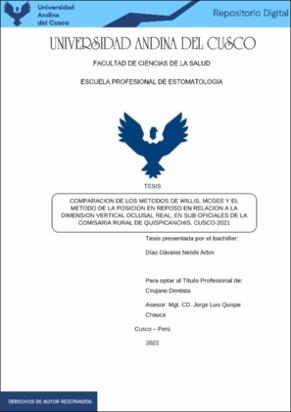| dc.contributor.advisor | Quispe Chauca, Jorge Luis | |
| dc.contributor.author | Díaz Dávalos, Nelshi Arbin | |
| dc.date.accessioned | 2022-11-17T15:22:46Z | |
| dc.date.available | 2022-11-17T15:22:46Z | |
| dc.date.issued | 2022-08-15 | |
| dc.identifier.uri | https://hdl.handle.net/20.500.12557/4934 | |
| dc.description.abstract | La presente investigación tuvo como propósito comparar la dimensión vertical
oclusal Real (DVOr), con las medidas obtenidas mediante los métodos de
Willis, McGee y el Método de la posición en Reposo, todo esto en el mismo
participante para determinar cuál de estos métodos es el más preciso.
El estudio fue realizado en una muestra de 120 suboficiales de la comisaria
sectorial de Quispicanchis, la investigación fue de nivel tipo Correlacional,
cuantitativa,
transversal. Los participantes
fueron seleccionados
aleatoriamente, con edades entre los 20 y 30 años, con dentadura permanente,
sin tratamiento ortodóntico previo ni actual, que no sean portadores de prótesis
fija o removible. Se utilizaron vernier digital para medir la Dimensión Vertical
Oclusal Real, la regla o compas de Willis, para determinar la distancia entre la
comisura externa del ojo hasta la comisura labial, con el vernier digital para
tomar las medidas Glabela-Subnasal, pupila y línea divisoria de los labios, y
distancia Inter comisural labial recorriendo el perímetro y luego dividirlas entre
3, y una regla metálica para obtener la distancia subnasal – mentón en posición
de reposo y restarle 3 mm.
Los resultados obtenidos fueron la Dimensión Vertical Oclusal Real tuvo una
media de 66.86, con el método de Willis una media de 66.98 mm, el método de
McGee una media de 65.35 mm y el método de la Posición en Reposo una
media de 68.49.
El método de Willis demostró un mayor grado de precisión en relación a la
dimensión vertical oclusal real, en comparación al método de McGee y el
método de la Posición en Reposo. | es_PE |
| dc.description.abstract | The purpose of this research was to compare the Real vertical occlusal
dimension (RVOD) with the measurements obtained by the Willis and McGee
methods and the Resting Position Method, all this in the same participant to
determine which of these methods is the most accurate.
The study was carried out in a sample of 120 sub-officers of the Quispicanchis
police station, the research was of a correlational, quantitative, cross-sectional
type. The participants were randomly selected, aged between 20 and 30 years,
with permanent dentition, without previous or current orthodontic treatment, and
not wearing fixed or removable prosthesis. A digital vernier was used to
measure the Real Vertical Occlusal Dimension, the Willis Compass to find the
distance between the external commissure of the eye and the labial
commissure, the digital vernier to take the Glabella-Subnasal, pupil, and
dividing line of the lips, and the Inter commissural-lip distance along the
perimeter and then divide them by 3, and a metallic ruler to obtain the subnasalchin
distance
in
resting
position
and
subtract
3
mm.
The results obtained were the True Vertical Occlusal Dimension had a mean of
66.86, with the Willis method a mean of 66.98 mm, McGee's method a mean of
65.35 mm, and the Resting Position method a mean of 68.49.
The Willis method demonstrated a higher degree of accuracy about the actual
occlusal vertical dimension compared to the McGee method and the Resting
Position method. | en_US |
| dc.format | application/pdf | es_PE |
| dc.language.iso | spa | es_PE |
| dc.publisher | Universidad Andina del Cusco | es_PE |
| dc.rights | info:eu-repo/semantics/openAccess | es_PE |
| dc.rights.uri | https://creativecommons.org/licenses/by-nc-nd/4.0/ | es_PE |
| dc.subject | Tratamiento ortodóntico | es_PE |
| dc.subject | Suboficiales de la comisaria | es_PE |
| dc.subject | Comisura labial | es_PE |
| dc.title | Comparación de los métodos de Willis, Mcgee y el método de la posición en reposo en relación con la dimensión vertical oclusal real, en sub-oficiales de la comisaria rural de Quispicanchis, Cusco-2021 | es_PE |
| dc.type | info:eu-repo/semantics/bachelorThesis | es_PE |
| thesis.degree.name | Cirujano Dentista | es_PE |
| thesis.degree.grantor | Universidad Andina del Cusco. Facultad de Ciencias de la Salud | es_PE |
| thesis.degree.discipline | Estomatología | es_PE |
| dc.publisher.country | PE | es_PE |
| dc.subject.ocde | https://purl.org/pe-repo/ocde/ford#3.02.14 | es_PE |
| renati.advisor.dni | 40975702 | |
| renati.advisor.orcid | https://orcid.org/0000-0002-1299-7907 | es_PE |
| renati.author.dni | 46624585 | |
| renati.discipline | 911016 | es_PE |
| renati.juror | Tamayo Vargas, Carlos Máximo | |
| renati.juror | Ucañani Ascue, Nancy Elizabeth | |
| renati.juror | Valer Contreras, Aida | |
| renati.juror | Gutierrez Acuña, Yenny | |
| renati.level | https://purl.org/pe-repo/renati/level#tituloProfesional | es_PE |
| renati.type | https://purl.org/pe-repo/renati/type#tesis | es_PE |


